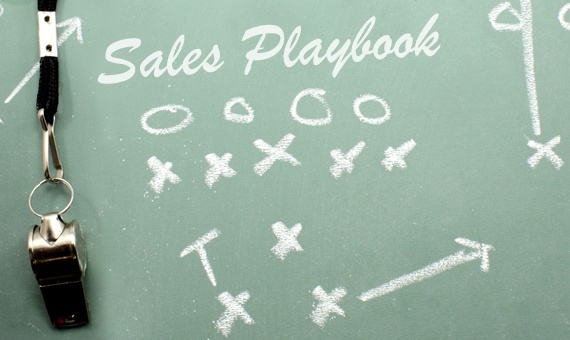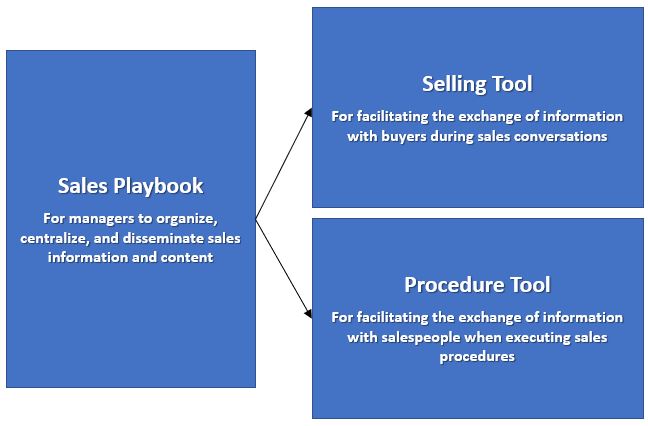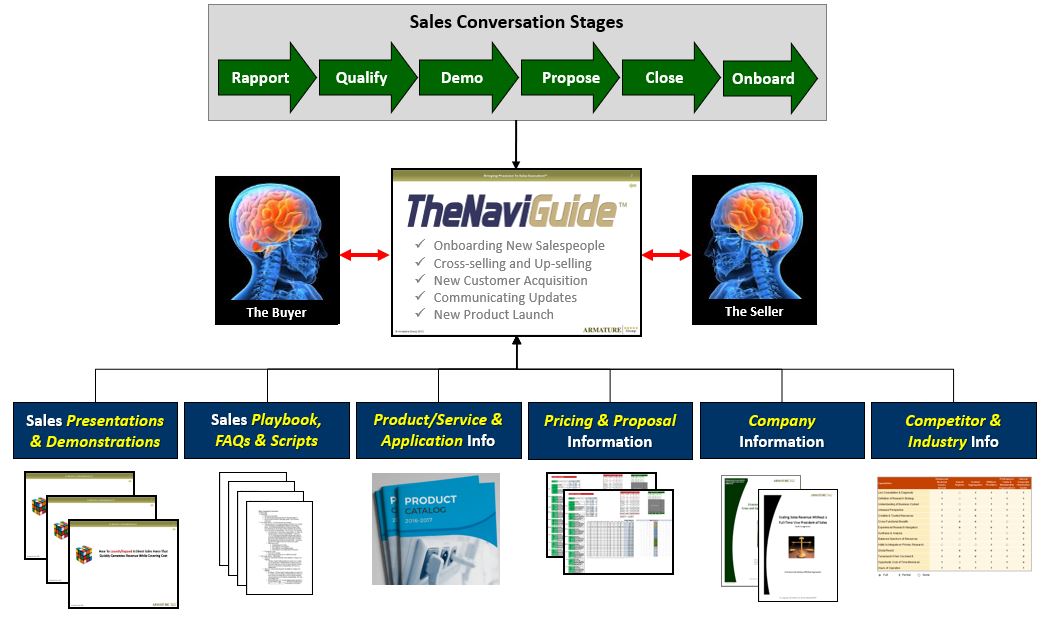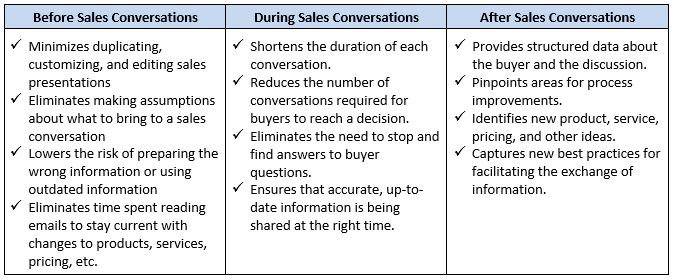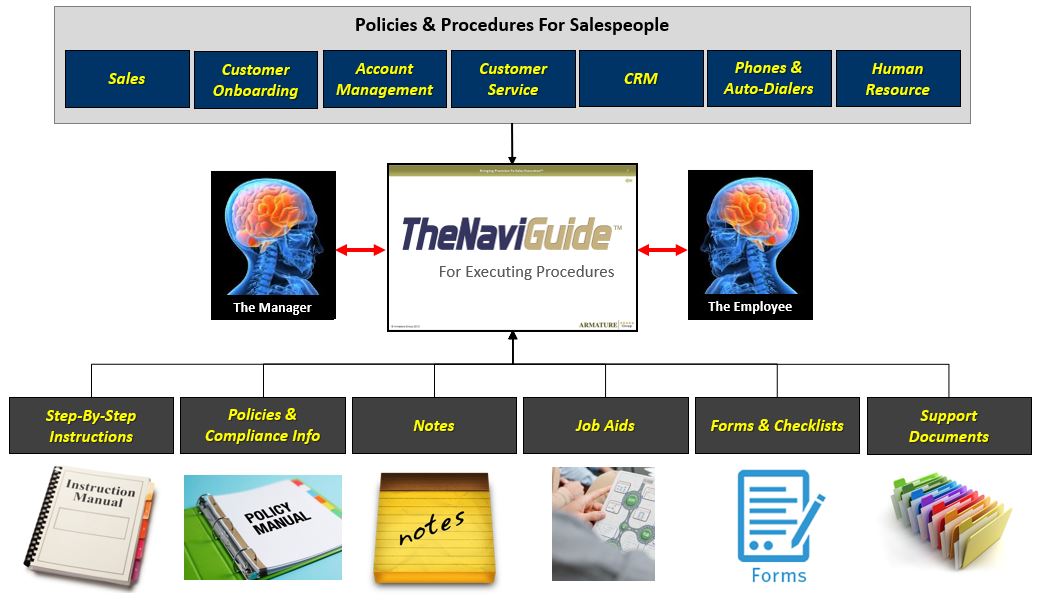Executive Summary
A sales playbook is a great management tool for getting sales, product, pricing, and marketing managers on the same page. In short, it helps them define, organize, centralize, and disseminate five categories of best practice information and content. Unfortunately, a sales playbook causes salespeople to stop selling. It forces them to spend time learning, planning, and researching. So, salespeople are reluctant to use a sales playbook.
Time is the enemy of salespeople. Whether you’re an insurance producer, accounting firm partner, software inside sales rep, engineering firm sales engineer, or field sales rep. This is especially true when onboarding new salespeople. Large, financially strong companies want to reduce onboarding time to add profits to the bottom line. Start-ups and small companies want to reduce onboarding time, so they can afford to hire salespeople. Yet they struggle to get salespeople to use a sales playbook.
In short, we found that salespeople will use a sales playbook when it’s converted into two tools that help them execute their work. A selling tool that equips salespeople to instantly and accurately apply sales information and content during sales conversations. And a process tool that equips salespeople to instantly and accurately apply process information and content when executing sales procedures. Both tools equip salespeople to:
- Execute with precision – – effectively, efficiently, and predictably.
- Instantly and accurately apply sales information and content.
- Avoid spending time learning, planning, researching, and disrupting managers.
In summary, this post will show you how to get salespeople to use a sales playbook without causing them to spend time learning, planning, and researching.
What Is A Sales Playbook?
To understand how to get salespeople to use a sales playbook, it helps to understand its purpose. In simple terms, a sales playbook is a management tool. It gets sales, product, pricing, and marketing managers on the same page. To that end, a sales playbook helps them define, organize, centralize, and disseminate five categories of information and content including:

- What to Know. What are we selling? Who are we selling to? What problems are we solving
- What to Say. Including conversation tracks, messages, questions, and stories.
- What to Show. Including sales presentations, videos, handouts, comparisons, etc.
- What to Do. Including best practices i.e. selling skills, procedures, policies.
- What to Measure. To ensure that revenue and profitability goals are being met.
On the positive side, a sales playbook is used for sales training, onboarding, planning, and communications. It captures and shares best practices and lessons learned. On the negative side, it reduces but does not eliminate, the amount of time that:
- New salespeople spend learning offerings, customers, procedures, and other information.
- Existing salespeople spend doing research before, during, and after sales conversations.
- Poor performing salespeople re-learning information and content and doing research before, during, and after sales conversations.

Sales playbooks have been around for decades. In the beginning, they were placed in a three-ring binder. Then they evolved into a digital document. The next generation will allow sales information and content to be automatically accessed online through CRM or email. Not to mention the endless artificial intelligence (AI) possibilities. In summary, thousands of companies have spent time and money building sales playbooks.
So, why are salespeople reluctant to use them?
Why Are Salespeople Reluctant to Use A Sales Playbook?
Nearly every company that we have worked his has spent time building a sales playbook. And they all struggle to get salespeople to consistently use them. In simple terms, we found that a sales playbook causes salespeople to stop selling. It forces them to spend time learning, planning, and researching. This takes them away from selling.
Learning company offerings and operations by:
- Reading documents, reviewing website pages, and watching videos.
- Taking and organizing notes on what they were learning.
- Studying and memorizing that information.
- Meeting with technical experts to ask questions.
- Attending training classes led by technical experts.
- Completing self-paced eLearning programs.
Information included:
- Products and services.
- Applications of the products and services.
- Pricing, discounts, contract terms and conditions.
- Value propositions and unique differentiation.
- Competitors and their vulnerabilities.
- Customers industries and their customers.
Planning their sales approach by:
- Studying and memorizing sales playbooks, FAQ’s, and scripts.
- Listening to recordings of sales conversations.
- Participating in field sales meetings to learn from other salespeople.
- Crafting sticky notes, checklists, and scripts to help them remember what to say and do.
- Creating their own sales conversation decision tree.
- Rehearsing their sales approach and participating in mock sales conversations.
Information included:
- Questions to understand buyers situation, problems, impact, and need to resolve.
- Explanations to demonstrate products, services, features, functions, and benefits.
- Formulas and calculations to create the right pricing and proposals.
- Negotiating points, terms, and conditions to close deals.
- Objection handling tactics across all steps of the sales conversation.
- Market knowledge i.e. industry, company, department, process, etc.
- Competitor knowledge i.e. offerings, unique differentiation, comparison points.
Researching content, questions, and answers by:
- Flipping through sales presentations, playbooks, and scripts.
- Disrupting technical experts via phone call, TXT, email
and stopping by their office. - Looking for information in databases, wikis, online shared folders, and websites.
- Talking to other salespeople and their sales manager.
Content included:
- Sales playbooks and Wikis.
- Sales presentations and templates.
- Scripts and talk tracks.
FAQ’s .- Product and service sheets and manuals.
Simply put, salespeople are not paid to spend time learning, planning, and researching sales information and content. They are paid to apply sales information and content to sell, generate opportunities, and close deals.
We found that the best way to get salespeople to use a sales playbook is to eliminate the need for them to spend time learning, planning, and researching. The key is to equip salespeople to instantly apply sales information and content so they can spend more time selling.

How Can We Equip Salespeople to Instantly Apply Sales Information and Content?
To answer this question, we started by categorizing the sales information and content contained in a sales playbook. We found two distinct sets of sales information and content.
The first set is used by salespeople to execute sales conversations with buyers includes:
- Products and services including applications, unique differentiation, pricing model.
- Competitive intelligence and comparisons.
- Buyer personas including how to engage different types of buyers.
- Messaging including email templates, positioning statements, scripts, and objection handling tips.
- Sales presentations and resource libraries for case studies, testimonials, customer references, etc.
The second set is used by salespeople to execute sales procedures includes:
- Company overview including purpose, values, objectives, and culture.
- Organization structure including sales channels, job descriptions, roles and responsibilities.
- The sales process steps and selling methodology i.e. Challenger Sale, SPIN, PSS, Sandler, etc.
- Key performance indicators (KPI’s).
- Compensation plan.
With this in mind, we concluded that we needed to equip salespeople with two tools. A selling tool that equips salespeople to instantly and accurately apply sales information and content during sales conversations. And a process tool that equips salespeople to instantly and accurately apply process information and content when executing sales procedures.
Tool #1 – How to Convert A Sales Playbook Into A Selling Tool
We decided to start by converting a sales playbook into a selling tool. Why? Because the sales conversation is where the buyer resides and the cash register rings. This led us to ask some basic questions about sales conversations.
First, what is the goal of a sales conversation? We believe the goal is to reach shared understandings and agreements, that preferably results in the buyer purchasing. Second, what is required for the buyer and seller to reach shared understandings and agreements? In simple terms, there is an exchange of information where the:
Buyer works to:
- Define and articulate their situation, problems, and priorities.
- Quantify the financial reason(s) to solve the problem.
- Identify potential solutions.
- Evaluate and compare competing solutions.
- Make a yes/no purchase decision.
Seller works to:
- Build rapport and qualify buyer problems, needs, and wants.
- Demonstrate and explain products, services, applications, and value propositions.
- Present recommendations and proposals.
- Negotiate and close the sale.
- Handle objections at any point during the exchange of information.
Third, how do you improve the exchange of information between the buyer and seller?
To answer this question we observed and listened to thousands of sales conversations in five industry groups.
1. Software, information, and publishing
2. Professional service firms i.e. accounting, engineering, environmental
3. Agencies i.e. insurance, financial advisers, real estate
4. Franchises
5. Manufacturers and distributors
We observed salespeople struggling to perform ten tasks during sales conversations including:
- Getting and keeping the buyer on the same page throughout all stages of the sales conversation.
- Validating assumptions about what buyers know and don’t know. Assumptions about the seller’s company, offerings, and differentiation. Also about what buyer’s value when determining if a vendor/partner is worthy of doing business with. And what buyers want to discuss now versus later.
- Sequencing and accurately presenting the right questions and answer options at the right time to: understand the buyer’s situation, define and prioritize buyer problems, wants and needs; clarify the impact the problems are having; establish an economic reason for solving the problem.
- Answering questions about products, services, applications, and competitors that buyers know to ask and those that they don’t know to ask.
- Accessing and sharing information including demonstrations and comparisons, pricing and discounts, case studies and testimonials, product and service information sheets.
- Presenting proposals including preparing recommendation options, pricing, and discounts, terms, and conditions.
- Testing buyers at each stage of the exchange of information for understanding and agreement.
- Switching roles between talking, viewing and listening; interpreting and preparing responses; searching for information and documents.
- Mitigating differences with buyers including frames of reference and assumptions, language and terminology, knowledge and experience, the timing of decisions, personal agendas and priorities, personality styles.
- Remembering to apply selling skills and methods, company policies and procedures, best practices, legal compliance measures.
So, to get salespeople to use a sales playbook to execute sales conversation we needed to equip them with a tool that:
- Shows them how to execute the ten tasks above with precision – – effectively, efficiently, and predictably.
- Instantly and accurately applies sales information and content when facilitating the exchange of information with buyers during sales conversations.
- Helps them avoid spending time learning, planning, researching, and disrupting managers.
With this in mind, we set out to find a selling tool that could meet all three requirements.
A Selling Tool That Gets Salespeople To Use A Sales Playbook During Sales Conversations



Unfortunately, we could not find a selling tool that could meet all three requirements. Traditional selling tools focus on sales pitches and presentations. In fact, they block salespeople from facilitating the exchange of information with buyers. They also force salespeople to stop sales conversations to find sales information and content to answer buyer questions.
So, through a painstaking process of trial and error, we converted a sales playbook into a selling tool. One that met all three requirements. It accomplished this by:
- Using a decision tree to anticipate, organize, and map the most precise conversation sequence. This includes questions, answer options, explanations, demonstrations, recommendations, comparisons, proposals, negotiations, objection handling, and closing. This enabled the conversation to be logical, easy to follow, and quick.
- Visually presenting the right questions and answer options at the right time during the exchange of information. This increased the accuracy of what was discussed while minimizing confusion and the need for verbal explanations.
- Equipping buyers to prioritize conversation topics based on their situation and problems. This increased buyer engagement and increased the relevancy of what was being discussed.
- Providing “one-click” access to information needed by the buyer and seller to complete the exchange of information. This minimized interruptions and the need to prematurely end a sales conversation to find information.
- Using plain English and simple visuals. This minimized misinterpretations and the need to ask clarifying questions.
- Embedding application of selling skills and best practices. This extracted ROI from previous investments in sales training. It also enabled uniform application from sales conversation-to-conversation and sales person-to-person.
- Distributing real-time updates of technical information, selling skills, and best practices. This ensured use of the most current information, skills, and practices. It also nearly eliminated time spent reading emails, attending webinars, and participating in training.
- Eliminating the need for multiple sales presentations, scripts and documents. This reduced confusion about what documents to use and eliminated the need to create new slides and presentations.
In simple terms, salespeople that have used this selling tool affectionately refer to it as TheNaviGuide for Selling.
How Does This Selling Tool Impact Results?
We found that converting a sales playbook into a selling tool increased adoption by salespeople. More specifically, we experienced positive results in four areas. First, TheNaviGuide nearly eliminated the need for new salespeople to spend time: 1) learning company offerings, 2) preparing their sales approach, 3) searching for information, and 4) managing/venting their frustration. As illustrated above, everything they needed to conduct sales conversations, generate opportunities, and close sales was in TheNaviGuide. If it wasn’t, we added it.
Second, TheNaviGuide reduced the time that sales managers and technical experts spent with new salespeople: 1) training, 2) handling complaints, 3) correcting mistakes, 4) re-explaining information, and 5) answering their frequent questions.
Third, we found that new salespeople used TheNaviGuide as a selling tool for conducting sales conversations. In fact, it enabled them to precisely guide buyers through the exchange of information from sales conversation-to-conversation. It helped them:
Four, TheNaviGuide simultaneously solved four additional sales team problems:
- Performance improvement planning (PIP) for under-performing salespeople. It equipped them to facilitate the exchange of information with buyers during sales conversations. It also reduced coaching time.
Communicating product, pricing and other changes to salespeople by up-to-dating the tool daily. This eliminated the need for salespeople to read update emails and attend training meetings/webinars.- New product launch training for salespeople. The tool equipped salespeople to immediately begin selling and generating opportunities for new offerings without training.
- Post-merger cross-selling. It immediately salespeople to sell both company’s offerings without training.
In simple terms, TheNaviGuide saves time, money, morale, and careers.
Tool #2 – How Do You Convert A Sales Playbook Into A Procedure Execution Tool?
We followed a similar approach to convert a sales playbook into a sales procedure execution tool. We started by asking some basic questions about sales procedures. First, what is the goal of a sales procedure? We believe the goal is to reach shared understandings and agreements that result in salespeople executing sales procedures with precision. Precision is defined as effective, efficient, and predictable.
Second, what is required for salespeople and managers to reach shared understandings and agreements about sales procedures? In simple terms, there is an exchange of information where:
Sales managers work to:
- Define sales procedures.
- Document step-by-step instructions for each sales procedure.
- Present sales procedures and step-by-step instructions to salespeople.
- Demonstrate how to use each sales procedure.
- Answer emergent questions from salespeople about sales procedures.
- Handle questions and objections about using sales procedures.
- Identify improvements for sales procedures.
Salespeople work to:
- Understand sales procedures and step-by-step instructions.
- Determine what sales procedure to use in each situation.
- Locate the right sales procedure at the right time.
- Follow the step-by-step instructions for each sales procedure.
- Get timely answers to questions about instructions.
- Determine next steps after completing a sales procedure.
- Share ideas to improve sales procedures
Third, where are salespeople struggling when executing sales procedures?
So, to answer this question, we observed thousands of salespeople execute sales procedures in five industry groups.
1. Software, information, and publishing
2. Professional service firms i.e. accounting, engineering, environmental
3. Agencies i.e. insurance, financial advisers, real estate
4. Franchises
5. Manufacturers and distributors
We found salespeople struggling to instantly and accurately execute sales procedures including:
- Remembering step-by-steps instructions.
- Finding and accessing the right step-by-step instructions.
- Understanding and recalling the right if/then choices within sales procedures.
- Validating assumptions about which sales procedure to use.
- Sequencing and accurately executing the right step-by-step instructions at the right time.
- Answering questions from their peers about how to execute step-by-step instructions.
- Getting timely answers to their questions about sales procedures

So, to get salespeople to use a sales playbook to execute sales procedures we needed to equip them with a tool that:
- Shows them how to execute the tasks above with precision – – effectively, efficiently, and predictably.
- Instantly and accurately applies sales information and content when executing sales procedures.
- Helps them avoid spending time learning, planning, researching, and disrupting managers.
With this in mind, we set out to find a procedure execution tool that could equip our salespeople to handle these tasks?
A Sales Procedure Tool That Gets Salespeople To Use A Sales Playbook
Unfortunately, we could not find a sales procedure tool that could meet all three requirements. We found that traditional process tools focus on mapping procedures and storing documents. Unfortunately, they do not equip salespeople to instantly and accurately apply that information when executing sales procedures.
With this in mind, we applied some lessons learned from building TheNaviGuide for Selling. We created TheNaviGuide for Procedures which met all three requirements by:
- Using a decision tree to anticipate, organize, and map the most precise sequence of instructions for executing sales procedures. This enabled the procedure to be logical, easy to follow, and quick.
- Visually presenting the right instructions at the right time when executing a sales procedure. This increased the accuracy of execution while minimizing confusion and the need for verbal explanations.
- Equipping salespeople to prioritize categories of sales procedures based on their situation and problems. This increased buy-in from salespeople.
- Providing “one-click” access to step-by-step instructions to complete sales procedures.
- Using plain English and simple visuals. This minimized misinterpretations and the need to ask clarifying questions.
- Embedding application of lessons learned and best practices.
- Distributing real-time updates of sales procedures, lessons learned, and best practices. This ensured use of the most current information, skills, and procedures. It also nearly eliminated time spent reading emails, attending webinars, and participating in training.
- Eliminating the need for multiple sales procedure manuals and documents. This reduced confusion about what documents to use and eliminated the need to create new manuals and documents.
In simple terms, salespeople that have used this procedure tool affectionately refer to it as TheNaviGuide for Procedures.
How Does This Procedure Execution Tool Impact Results?
We found that converting a sales playbook into a procedure tool increased adoption by salespeople. More specifically, we experienced positive results in four areas. First, TheNaviGuide nearly eliminated the need for new salespeople to spend time: 1) learning sales procedures, 2) preparing reminders for executing sales procedures, and 3) searching for instructions and information. As illustrated above, everything they needed to execute sales procedures was in TheNaviGuide. If it wasn’t, we added it.
Second, TheNaviGuide reduced the time that sales managers and technical experts spent with new salespeople: 1) training, 2) handling complaints, 3) correcting mistakes, 4) re-explaining information, and 5) answering their frequent questions.
Third, we found that new salespeople used TheNaviGuide as a reference tool when executing sales procedures.
In short, TheNaviGuide converted a sales playbook into a sales procedure tool. It equipped salespeople to instantly and accurately execute sales procedures without spending time learning, planning, and researching.
Conclusion
In simple terms,
TheNaviGuide accomplishes this without causing salespeople to spend time learning, planning, and researching. In conclusion, TheNaviGuide saves time, money, morale, and careers.
Please Take a Minute To:
- Write a comment on this post
- Click Here to learn more about TheNaviGuide for Selling and how to implement it
- Click Here to learn more about TheNaviGuide for Process Management and how to implement it
- Share this blog with other sales leaders, salespeople, CEO’s and investors
It’s time to bring precision – – effectiveness, efficiency, and predictability – – to sales execution.

